Evaluation of Spatial Landscape Changes for the Period from 1998 to 2021 Caused by Extreme Flood Events in the Hornád Basin in Eastern Slovakia
Abstract
:1. Introduction
2. Materials and Methods
2.1. Study Area and Vulnerability to Flood Events
2.2. Data Collection and Processing
- R10MM (heavy precipitation days)—RRij is the daily precipitation amount for day i of period j (calendar year). Then, the index value is calculated as
- R20MM (very heavy precipitation days)—RRij is the daily precipitation amount for day i of period j (calendar year). Then, the index value is calculated as:
- PRCPTOT (total precipitation in mm)—RRwj is the daily precipitation amount on a wet day (precipitation amount ≥ 1.0 mm) of period j (calendar year). Then, the index value is calculated as:
- RX5DAY (highest 5-day precipitation amount in mm)—RRkj is the precipitation amount for the 5-day interval k of period j (calendar year). Then, the index value is calculated as:
2.3. Integrated Methodological Framework for Flood Event Impact Evaluation on Selected Indicators of Landscape Changes
- Flood event simulations;
- Historical evaluation of land use and other identified land cover patterns;
- Landscape temporal and spatial/spectral indexes.
2.4. In Situ Survey of Dynamic Changes in Landscape and Procedure
2.5. Modelling of the Study Area
2.5.1. Digital Relief Model Definition
2.5.2. Corine Land Cover
2.5.3. Hydrodynamic Model and Flooding Events Simulation
3. Results and Discussion
3.1. Meteorological Data Evaluation and Flood Evaluation
- Cloud cover (okta);
- Wind speed (m/s);
- Humidity (%);
- Global radiation (W/m2);
- Precipitation (mm);
- Snow depth (cm);
- Sunshine (hours);
- Temperature (°C), including daily mean, max, and min temperatures.
3.2. Analysis of Time Series Changes in the Landscape Structure
4. Conclusions
Author Contributions
Funding
Data Availability Statement
Acknowledgments
Conflicts of Interest
References
- Miller, J.D.; Brewer, T. Refining flood estimation in urbanized catchments using landscape metrics. Landsc. Urban Plan. 2018, 175, 34–49. [Google Scholar] [CrossRef]
- Peng, Y.; Wang, Q.; Wang, H.; Lin, Y.; Song, J.; Cui, T.; Fan, M. Does landscape pattern influence the intensity of drought and flood? Ecol. Indic. 2019, 103, 173–181. [Google Scholar] [CrossRef]
- Devi, N.N.; Sridharan, B.; Kuiry, S.N. Impact of urban sprawl on future flooding in Chennai city, India. J. Hydrol. 2019, 574, 486–496. [Google Scholar] [CrossRef]
- Peterson, C.D.; Minor, R.; Peterson, G.L.; Gates, E.B. Pre-and post-Missoula flood geomorphology of the Pre-Holocene ancestral Columbia River Valley in the Portland forearc basin, Oregon and Washington, USA. Geomorphology 2011, 129, 276–293. [Google Scholar] [CrossRef]
- Hu, C.; Xia, J.; She, D.; Song, Z.; Zhang, Y.; Hong, S. A new urban hydrological model considering various land covers for flood simulation. J. Hydrol. 2021, 603, 126833. [Google Scholar] [CrossRef]
- Zhang, Y.; Sun, F.; Pan, M.; Niel, T.V.; Wegehenkel, M. Hydrological Processes in Changing Climate, Land Use, and Cover Change. Adv. Meteorol. 2016, 2016, 7273414. [Google Scholar] [CrossRef]
- Su, M.; Zheng, Y.; Hao, Y.; Chen, Q.; Chen, S.; Chen, Z.; Xie, H. The influence of landscape pattern on the risk of urban water-logging and flood disaster. Ecol. Indic. 2018, 92, 133–140. [Google Scholar] [CrossRef]
- Malíková, L. Zmena využitia zeme vo vybraných poľnohospodársky znevýhodnených oblastiach SR. In Student Scientific Conference PriF UK 2014; Comenius University Bratislava: Bratislava, Slovakia, 2014. [Google Scholar]
- Liu, Y.; Han, J.; Jiao, J.; Liu, B.; Ge, W.; Pan, Q.; Wang, F. Responses of flood peaks to land use and landscape patterns under extreme rainstorms in small catchments—A case study of the rainstorm of Typhoon Lekima in Shandong, China. Int. Soil Water Conserv. Res. 2022, 10, 228–239. [Google Scholar] [CrossRef]
- Fu, S.; Yang, Y.; Liu, B.; Liu, H.; Liu, J.; Liu, L.; Li, P. Peak flow rate response to vegetation and terraces under extreme rainstorms. Agric. Ecosyst. Environ. 2020, 288. [Google Scholar] [CrossRef]
- Gergeľová, M.B.; Kuzevičová, Ž.; Labant, S.; Gašinec, J.; Kuzevič, Š.; Unucka, J.; Liptai, P. Evaluation of Selected Sub-Elements of Spatial Data Quality on 3D Flood Event Modeling: Case Study of Prešov City, Slovakia. Appl. Sci. 2020, 10, 820. [Google Scholar] [CrossRef] [Green Version]
- Zeleňáková, M.; Fijko, R.; Labant, S.; Weiss, E.; Markovič, G.; Weiss, R. Flood risk modelling of the Slatvinec stream in Kružlov village, Slovakia. J. Clean. Prod. 2019, 212, 109–118. [Google Scholar] [CrossRef]
- Doorga, J.R.S.; Magerl, L.; Bunwaree, P.; Zhao, J.; Watkins, S.; Staub, C.G.; Rughooputh, S.D.D.V.; Cunden, T.S.M.; Lollchund, R.; Boojhawon, R. GIS-based multi-criteria modelling of flood risk susceptibility in Port Louis, Mauritius: Towards resilient flood management. Int. J. Disaster Risk Reduct. 2022, 67, 102683. [Google Scholar] [CrossRef]
- Kseňak, Ľ.; Pukanská, K.; Bartoš, K.; Blišťan, P. Assessment of the Usability of SAR and Optical Satellite Data for Monitoring Spatio-Temporal Changes in Surface Water: Bodrog River Case Study. Water 2022, 14, 299. [Google Scholar] [CrossRef]
- Farhadi, H.; Esmaeily, A.; Najafzadeh, M. Flood monitoring by integration of Remote Sensing technique and Multi-Criteria Decision Making method. Comput. Geosci. 2022, 160, 105045. [Google Scholar] [CrossRef]
- Li, J.; Bortolot, Z.J. Quantifying the impacts of land cover change on catchment-scale urban flooding by classifying aerial images. J. Clean. Prod. 2022, 344, 130992. [Google Scholar] [CrossRef]
- Li, J.; Zhou, K.; Xie, B.; Xiao, J. Impact of landscape pattern change on water-related ecosystem services: Comprehensive analysis based on heterogeneity perspective. Ecol. Indic. 2021, 133, 108372. [Google Scholar] [CrossRef]
- Macchione, F.; Costabile, P.; Costanzo, C.; Lorenzo, G.D. Extracting quantitative data from non-conventional information for the hydraulic reconstruction of past urban flood events. A case study. J. Hydrol. 2019, 576, 443–465. [Google Scholar] [CrossRef]
- Kovanič, Ľ.; Blistan, P.; Urban, R.; Štroner, M.; Blišťanová, M.; Bartoš, K.; Pukanská, K. Analysis of the Suitability of High-Resolution DEM Obtained Using ALS and UAS (SfM) for the Identification of Changes and Monitoring the Development of Selected Geohazards in the Alpine Environment—A Case Study in High Tatras, Slovakia. Remote Sens. 2020, 12, 3901. [Google Scholar] [CrossRef]
- Gogoi, P.P.; Vinoj, V.; Phukon, P. Role of Meteorology and Local Orography on a Flood Event in the Lower Subansiri Basin and Post-Flood Changes to Land Use and Land Cover. Curr. Sci. 2020, 118. [Google Scholar] [CrossRef]
- Březková, L.; Šálek, M.; Soukalová, E.; Starý, M. Predictability of flood events in view of current meteorology and hydrology in the conditions of the Czech Republic. Soil Water Res. 2008, 2, 156–168. [Google Scholar] [CrossRef] [Green Version]
- Chai, S.S.; Wong, W.K.; Goh, K.L. Rainfall Classification for Flood Prediction Using Meteorology Data of Kuching, Sarawak, Malaysia: Backpropagation vs Radial Basis Function Neural Network. Int. J. Environ. Sci. Dev. 2017, 8, 385–388. [Google Scholar] [CrossRef]
- Kociuba, W. Different Paths for Developing Terrestrial LiDAR Data for Comparative Analyses of Topographic Surface Changes. Appl. Sci. 2020, 10, 7409. [Google Scholar] [CrossRef]
- Cieślak, I.; Biłozor, A.; Szuniewicz, K. The Use of the CORINE Land Cover (CLC) Database for Analyzing Urban Sprawl. Remote Sens. 2020, 12, 282. [Google Scholar] [CrossRef]
- Marčiš, M.; Fraštia, M.; Augustín, T. Measurement of Flat Slab Deformations by the Multi-Image Photogrammetry Method. Slovak J. Civ. Eng. 2017, 25, 19–25. [Google Scholar] [CrossRef]
- Cieślak, I.; Biłozor, A.; Źróbek-Sokolnik, A.; Zagroba, M. The Use of Geographic Databases for Analyzing Changes in Land Cover—A Case Study of the Region of Warmia and Mazury in Poland. ISPRS Int. J. Geo-Inf. 2020, 9, 358. [Google Scholar] [CrossRef]
- Ceppi, A.; Gambini, E.; Lombardi, G.; Ravazzani, G.; Mancini, M. SOL40: Forty Years of Simulations under Climate and Land Use Change. Water 2022, 14, 837. [Google Scholar] [CrossRef]
- Novillo, C.; Arrogante-Funes, P.; Romero-Calcerrada, R. Recent NDVI Trends in Mainland Spain: Land-Cover and Phytoclimatic-Type Implications. ISPRS Int. J. Geo-Inf. 2019, 8, 43. [Google Scholar] [CrossRef]
- Szabó, L.; Deák, B.; Bíró, T.; Dyke, G.J.; Szabó, S. NDVI as a Proxy for Estimating Sedimentation and Vegetation Spread in Artificial Lakes—Monitoring of Spatial and Temporal Changes by Using Satellite Images Overarching Three Decades. Remote Sens. 2020, 12, 1468. [Google Scholar] [CrossRef]
- Gozdowski, D.; Žukovskis, J.; Razinkovas-Baziukas, A.; Wójcik-Gront, E. Land Cover Changes in Selected Areas Next to Lagoons Located on the Southern Coast of the Baltic Sea, 1984–2021. Sustainability 2022, 14, 2006. [Google Scholar] [CrossRef]
- Miklós, L. Atlas Krajiny Slovenskej Republiky, 1st ed.; Ministerstvo životného prostredia SR: Bratislava, Slovakia, 2002. [Google Scholar]
- Jha, M.K. Impacts of Landscape Changes on Water Resources. Water 2020, 12, 2244. [Google Scholar] [CrossRef]
- Rendenieks, Z.; Tērauds, A.; Nikodemus, O.; Brūmelis, G. Comparison of input data with different spatial resolution in landscape pattern analysis—A case study from northern Latvia. Appl. Geogr. 2017, 83, 100–106. [Google Scholar] [CrossRef]
- Zhao, C.; Sander, H.A. Assessing the sensitivity of urban ecosystem service maps to input spatial data resolution and method choice. Landsc. Urban Plan. 2018, 175, 11–22. [Google Scholar] [CrossRef]
- Ding, Y.; Yang, X.; Wang, Z.; Fu, D.; Li, H.; Meng, D.; Zeng, X.; Zhang, J. A Field-Data-Aided Comparison of Three 10 m Land Cover Products in Southeast Asia. Remote Sens. 2022, 14, 5053. [Google Scholar] [CrossRef]
- Schmid, M.; Heinimann, A.; Zaehringer, J.G. Patterns of land system change in a Southeast Asian biodiversity hotspot. Appl. Geogr. 2021, 126, 102380. [Google Scholar] [CrossRef]
- Feloni, E.; Mousadis, I.; Baltas, E. Flood vulnerability assessment using a GIS-based multi-criteria approach—The case of Attica region. J. Flood Risk Manag. 2020, 13, e12563. [Google Scholar] [CrossRef]
- Chudý, R.; Iring, M.; Feciskanin, R. Evaluation of the Data Quality of Digital Elevation Models in the Context of Inspire / Hodnotenie Kvality Digitálnych Výškových Modelov V Kontexte Inspire. GeoScience Eng. 2013, 59, 9–24. [Google Scholar] [CrossRef]
- Podhorányi, M.; Unucka, J.; Bobál, P.; Říhová, V. Effects of LIDAR DEM resolution in hydrodynamic modelling: Model sensitivity for cross-sections. Int. J. Digit. Earth 2013, 6, 3–27. [Google Scholar] [CrossRef]
- Saleem, N.; Huq, M.E.; Twumasi, N.Y.D.; Javed, A.; Sajjad, A. Parameters Derived from and/or Used with Digital Elevation Models (DEMs) for Landslide Susceptibility Mapping and Landslide Risk Assessment: A Review. ISPRS Int. J. Geo-Inf. 2019, 8, 545. [Google Scholar] [CrossRef]
- Vojtek, M.; Vojteková, J. Flood Susceptibility Mapping on a National Scale in Slovakia Using the Analytical Hierarchy Process. Water 2019, 11, 364. [Google Scholar] [CrossRef]
- Choubin, B.; Moradi, E.; Golshan, M.; Adamowski, J.; Sajedi-Hosseini, F.; Mosavi, A. An ensemble prediction of flood susceptibility using multivariate discriminant analysis, classification and regression trees, and support vector machines. Sci. Total Environ. 2019, 651, 2087–2096. [Google Scholar] [CrossRef]
- Antzoulatos, G.; Kouloglou, I.-O.; Bakratsas, M.; Moumtzidou, A.; Gialampoukidis, I.; Karakostas, A.; Lombardo, F.; Fiorin, R.; Norbiato, D.; Ferri, M.; et al. Flood Hazard and Risk Mapping by Applying an Explainable Machine Learning Framework Using Satellite Imagery and GIS Data. Sustainability 2022, 14, 3251. [Google Scholar] [CrossRef]
- Falťan, V.; Petrovič, F.; Oťaheľ, J.; Feranec, J.; Druga, M.; Hruška, M.; Nováček, J.; Solár, V.; Mechurová, V. Comparison of CORINE Land Cover Data with National Statistics and the Possibility to Record This Data on a Local Scale—Case Studies from Slovakia. Remote Sens. 2020, 12, 2484. [Google Scholar] [CrossRef]
- Büttner, G. CORINE Land Cover and Land Cover Change Products; Springer: Dordrecht, The Netherlands, 2014; pp. 55–74. [Google Scholar]
- Verde, N.; Kokkoris, I.P.; Georgiadis, C.; Kaimaris, D.; Dimopoulos, P.; Mitsopoulos, I.; Mallinis, G. National Scale Land Cover Classification for Ecosystem Services Mapping and Assessment, Using Multitemporal Copernicus EO Data and Google Earth Engine. Remote Sens. 2020, 12, 3303. [Google Scholar] [CrossRef]
- Bates, P.D.; Roo, A.P.J.D. A simple raster-based model for flood inundation simulation. J. Hydrol. 2000, 236, 54–77. [Google Scholar] [CrossRef]
- Fárek, V.; Unucka, J.; Ponížilová, I.; Gergel’ová, M.; Židek, D.; Pallós, R. Assessment of the runoff conditions of small ungauged catchments using GIS and fully distributed hydrologic models. Acta Montan. Slovaca 2014, 19, 22–30. [Google Scholar]
- Gergel’ová, M.; Kuzevičová, Ž.; Kuzevič, Š.; Sabolová, J. Hydrodynamic modeling and GIS tools applied in urban areas. Acta Montan. Slovaca 2013, 18, 226–233. [Google Scholar]
- Chow, V.T. Open-Channel Hydraulics; McGraw-Hill: New York, NY, USA, 1959. [Google Scholar]
- Raplík, M.; Výbora, P.; Mareš, K. Úprava Tokov (Adjustments Flows); Alfa, Vydavateľstvo Technickej a Ekonomickej Literatúry: Bratislava, Slovakia, 1989. [Google Scholar]
- 52Huţanu, E.; Mihu-Pintilie, A.; Urzica, A.; Paveluc, L.E.; Stoleriu, C.C.; Grozavu, A. Using 1D HEC-RAS Modeling and LiDAR Data to Improve Flood Hazard Maps Accuracy: A Case Study from Jijia Floodplain (NE Romania). Water 2020, 12, 1624. [Google Scholar] [CrossRef]
- 53Tank, A.M.G.K.; Wijngaard, J.B.; Können, G.P.; Böhm, R.; Demarée, G.; Gocheva, A.; Mileta, M.; Pashiardis, S.; Hejkrlik, L.; Kern-Hansen, C.; et al. Daily dataset of 20th-century surface air temperature and precipitation series for the European Climate Assessment. Int. J. Climatol. 2002, 22, 1441–1453. [Google Scholar] [CrossRef]
- Kubinský, D.; Balážovič, Ľ.; Koleda, P.; Masný, M.; Weis, K.; Fuska, J. Copernicus Land Monitoring Service—Mapovanie krajinnej pokrývky na Slovensku. Geogr. Rev. 2019, 15, 58–73. [Google Scholar] [CrossRef]
- Falťan, V.; Oťaheľ, J.; Gábor, M.; Ružek, I. Land cover Research Methods—Metódy Výskumu Krajinnej Pokrývky; Comenius University Bratislava: Bratislava, Slovakia, 2018. [Google Scholar]
- Betancourt-Suárez, V.; García-Botella, E.; Ramon-Morte, A. Flood Mapping Proposal in Small Watersheds: A Case Study of the Rebollos and Miranda Ephemeral Streams (Cartagena, Spain). Water 2021, 13, 102. [Google Scholar] [CrossRef]
- Twisa, S.; Buchroithner, M.F. Land-Use and Land-Cover (LULC) Change Detection in Wami River Basin, Tanzania. Land 2019, 8, 136. [Google Scholar] [CrossRef] [Green Version]
- Copernicus Land Monitoring Service. Available online: https://land.copernicus.eu/user-corner/technical-library/clc-product-user-manual/view (accessed on 18 November 2022).
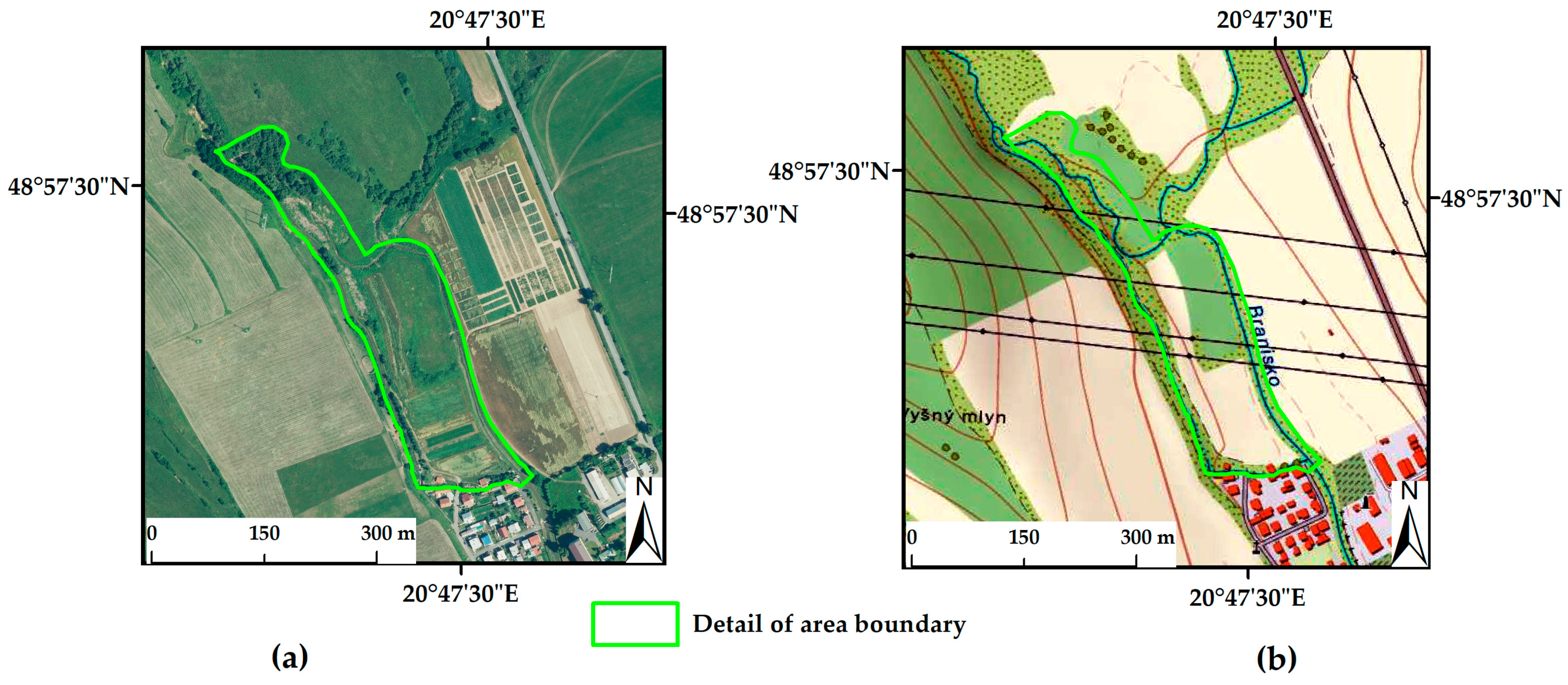

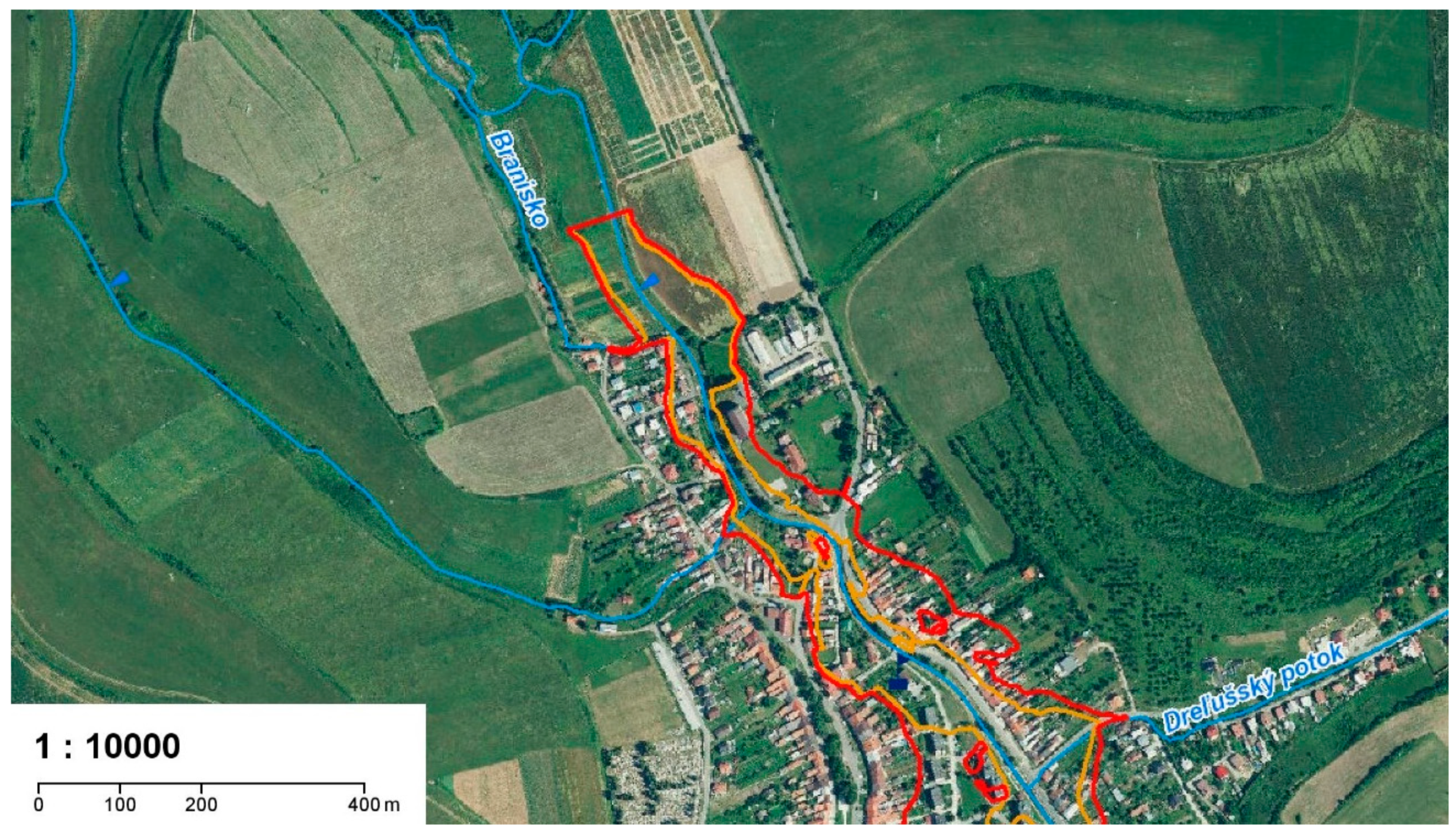
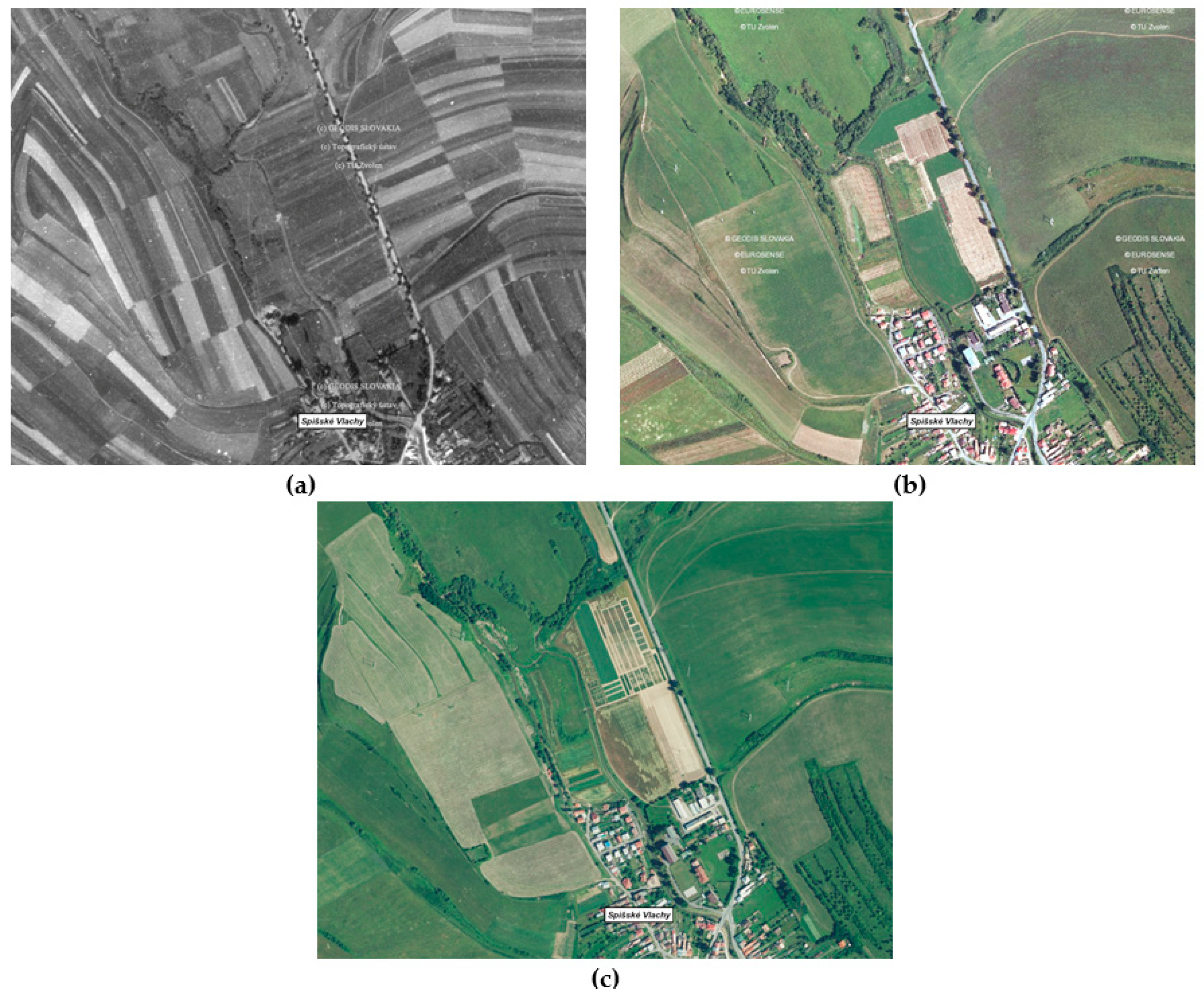


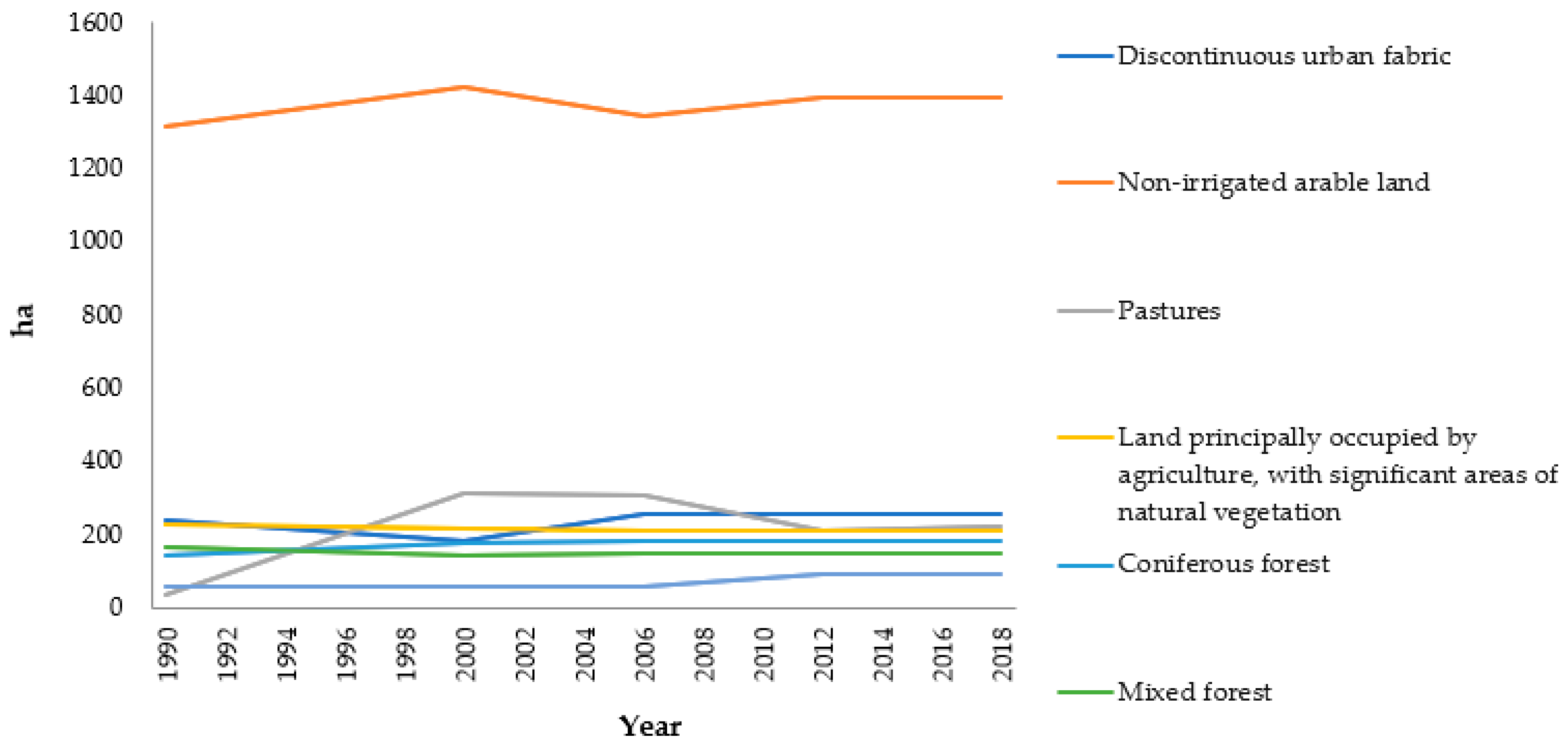
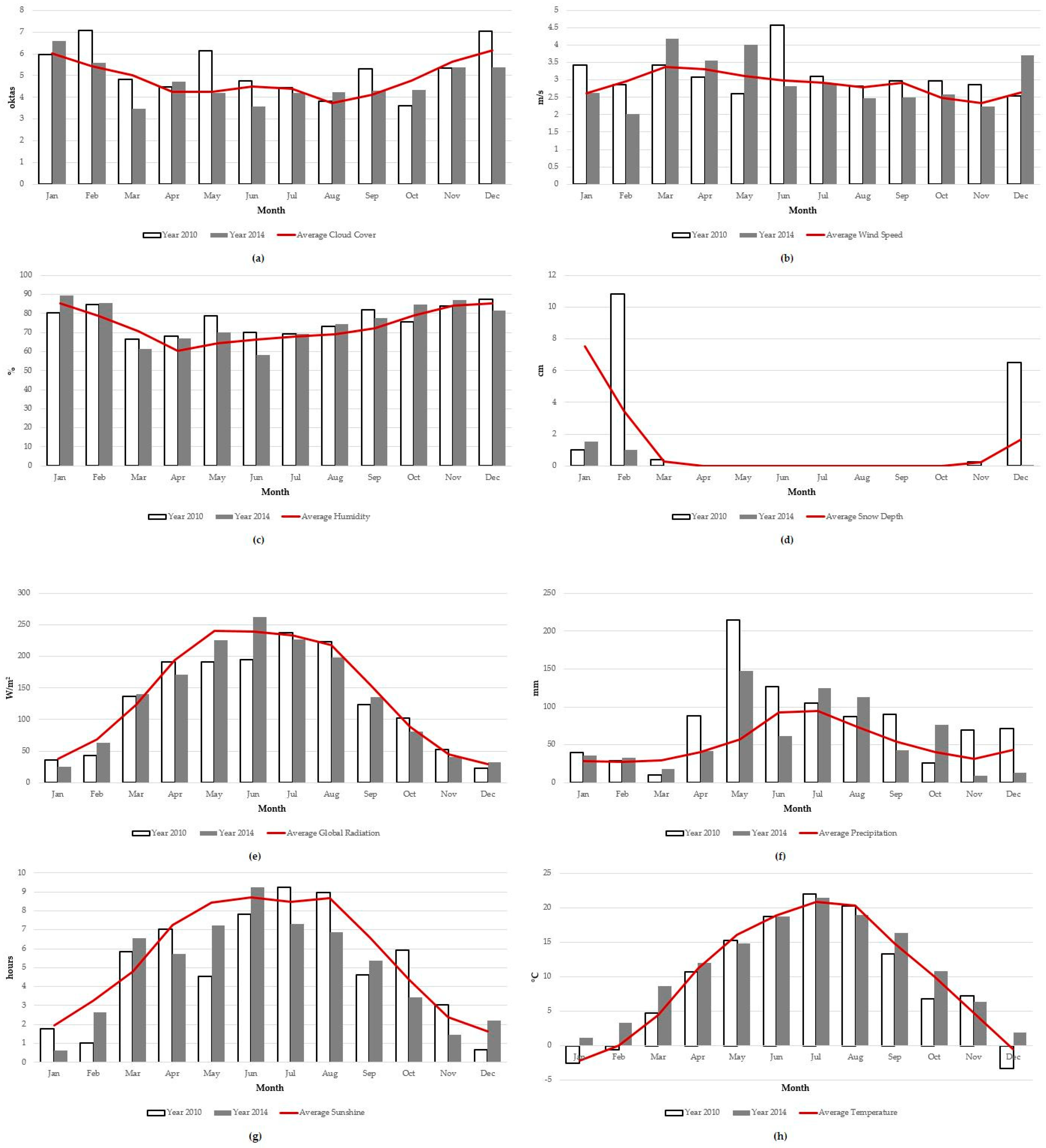


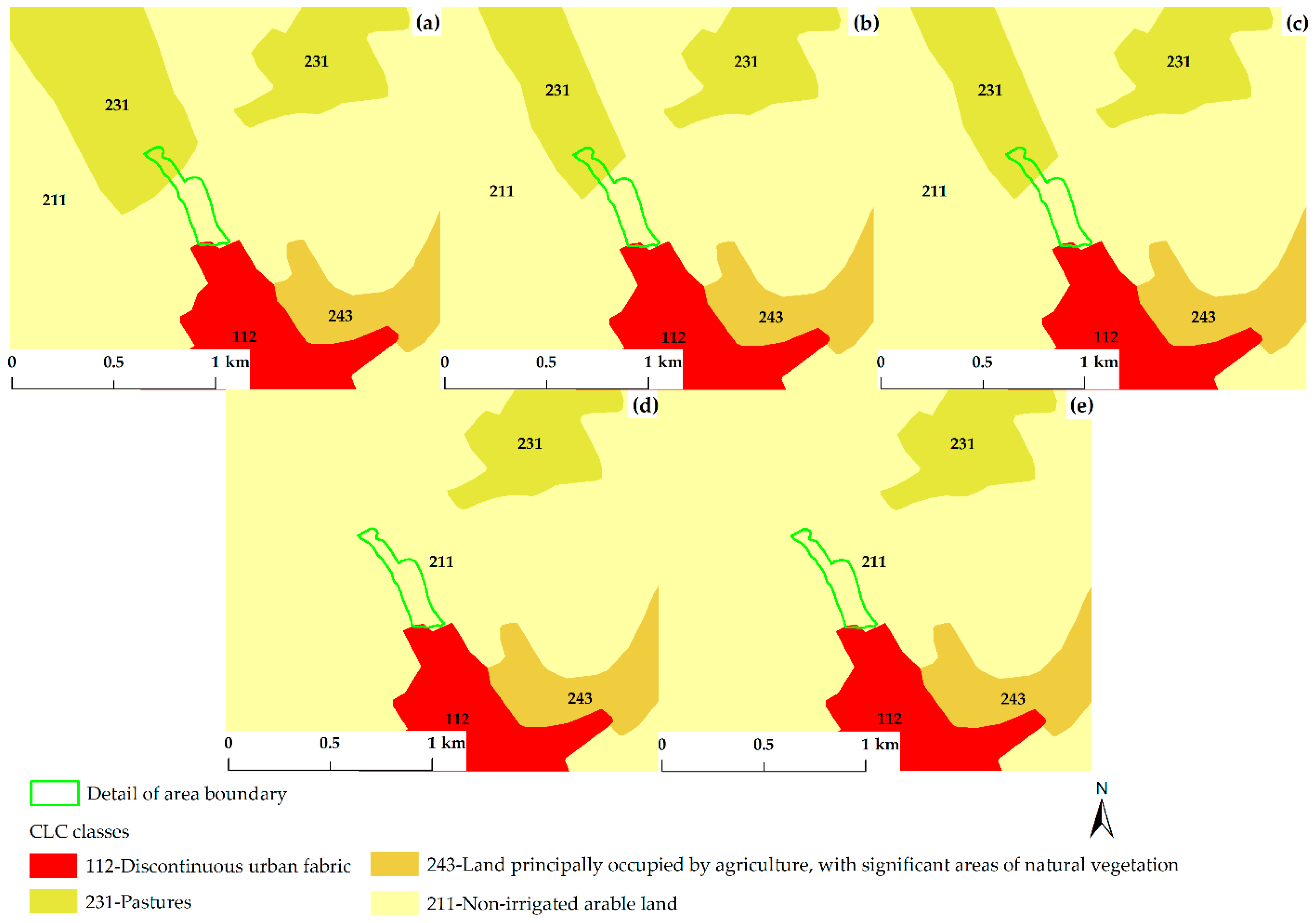

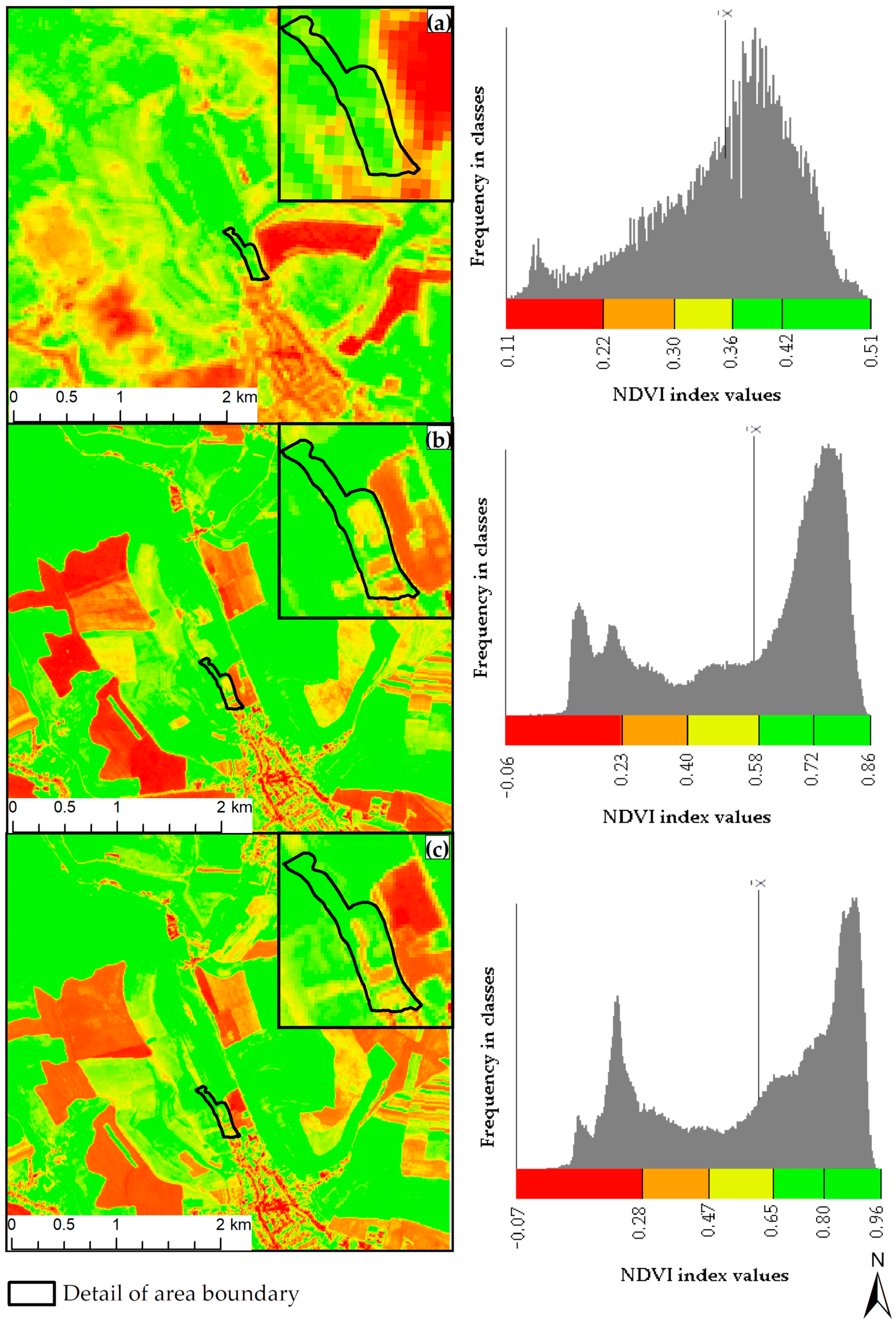
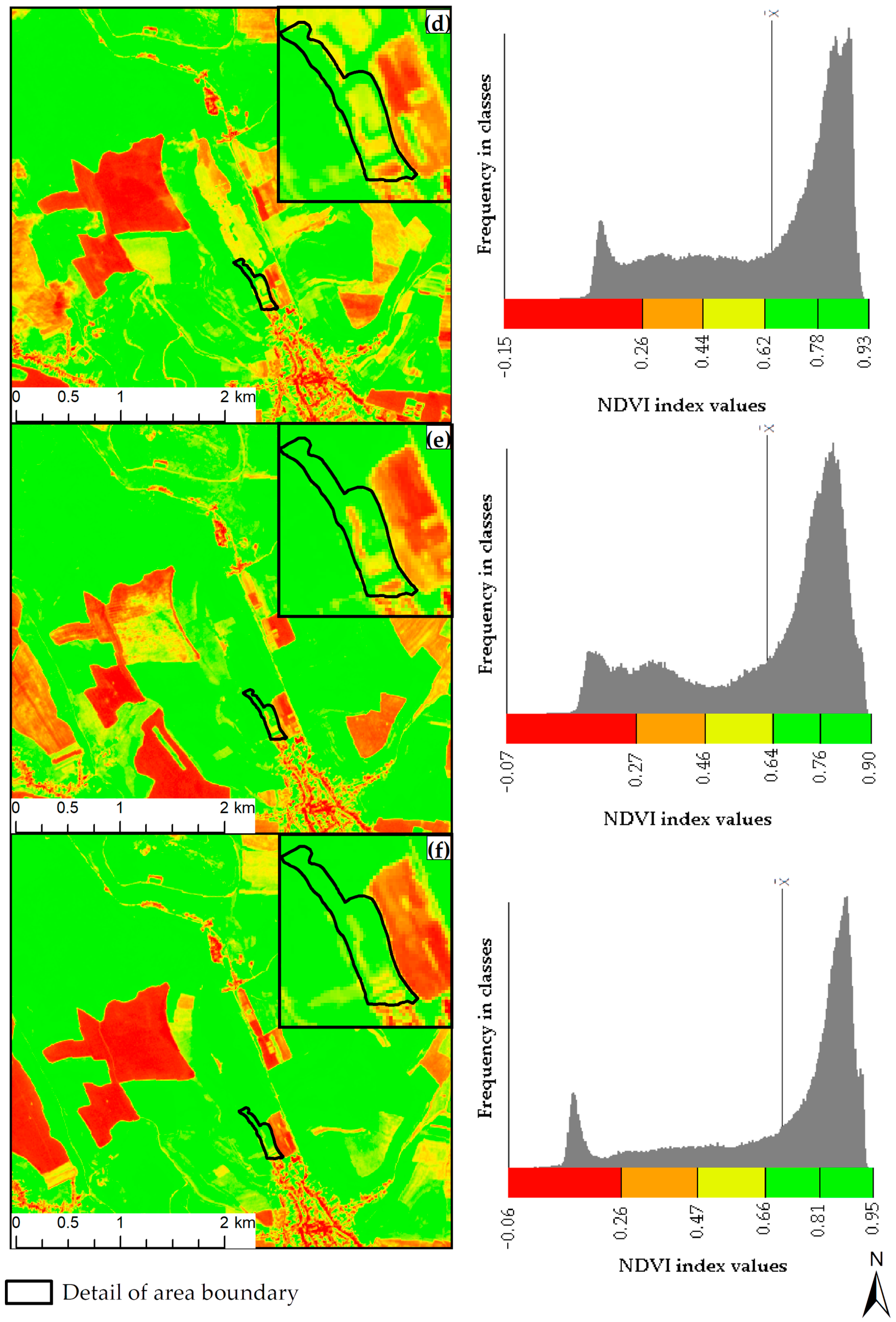

| NUTS 1 Level | NUTS 2 Level | NUTS 3 Level | LAU 1 Level | LAU 2 Level |
|---|---|---|---|---|
| Slovakia (SK0) | East Slovakia (SK04) | Košice region (SK042) | Spišská Nová Ves county (SK042A) | Spišské Vlachy village (SK042A543594) |
| Data Type | Temporal Coverage | Data Source | Data Format | Description |
|---|---|---|---|---|
| DMR 3.5 | 2014 | UGKK SR | .tiff | raster data—information about terrain characteristics and elevation |
| True Color Orthophotography | 2017–2018 | Copernicus | .tiff | raster/imagery data for verification process of local data linked to land cover changes |
| Copernicus data (Sentinel 2) | 2017/2021 TBC NDVI index | European Space Agency | .jpeg 2000 | raster/imagery data for derivation of NDVI |
| Landsat data (Landsat 4) | 1998 | U.S. Geological Survey | .tiff | raster/imagery data for derivation of NDVI |
| CLC—Corine land cover | 1990/2000/2006/2018 | Copernicus | .shp | vector data—classification of CLC categories |
| LPIS—Land Parcel Identification System | 2018/2020 | Open government data | .shp | vector data—parcel boundaries |
| Boundary area definition of Žehrica | 2018 | Own processing | .shp/.dwg | vector data—boundary of study area |
| Meteorological data | 1998–2021 | European Climate Assessment & Dataset | .csw | comprehensive data (daily/monthly measurements) from meteorological stations |
| CLC Level 3 Codes | 112 | 131 | 231 | 243 | 312 | 313 | 321 | |||||||
|---|---|---|---|---|---|---|---|---|---|---|---|---|---|---|
| Year | % | Δ% | % | Δ% | % | Δ% | % | Δ% | % | Δ% | % | Δ% | % | Δ% |
| 1990 | 9.62 | - | 53.63 | - | 12.76 | - | 9.28 | - | 5.83 | - | 6.63 | - | 2.23 | - |
| 2000 | 7.21 | −25.05 | 56.95 | 6.19 | 12.42 | −2.71 | 8.52 | −8.22 | 7.08 | 21.45 | 5.63 | −15.08 | 2.18 | −2.07 |
| 2006 | 10.29 | 42.70 | 53.70 | −5.71 | 12.31 | −0.88 | 8.42 | −1.15 | 7.19 | 1.50 | 5.86 | 3.98 | 2.23 | 2.20 |
| 2012 | 10.30 | 0.08 | 55.65 | 4.18 | 8.48 | −31.09 | 8.48 | 0.70 | 7.24 | 0.77 | 5.88 | 0.41 | 3.66 | 64.35 |
| 2018 | 10.26 | −0.40 | 55.72 | −0.40 | 8.85 | 4.33 | 8.45 | −0.40 | 7.22 | −0.40 | 5.86 | −0.40 | 3.65 | −0.40 |
Disclaimer/Publisher’s Note: The statements, opinions and data contained in all publications are solely those of the individual author(s) and contributor(s) and not of MDPI and/or the editor(s). MDPI and/or the editor(s) disclaim responsibility for any injury to people or property resulting from any ideas, methods, instructions or products referred to in the content. |
© 2023 by the authors. Licensee MDPI, Basel, Switzerland. This article is an open access article distributed under the terms and conditions of the Creative Commons Attribution (CC BY) license (https://creativecommons.org/licenses/by/4.0/).
Share and Cite
Gergelova, M.B.; Kovanič, L.; Abd-Elhamid, H.F.; Cornak, A.; Garaj, M.; Hilbert, R. Evaluation of Spatial Landscape Changes for the Period from 1998 to 2021 Caused by Extreme Flood Events in the Hornád Basin in Eastern Slovakia. Land 2023, 12, 405. https://doi.org/10.3390/land12020405
Gergelova MB, Kovanič L, Abd-Elhamid HF, Cornak A, Garaj M, Hilbert R. Evaluation of Spatial Landscape Changes for the Period from 1998 to 2021 Caused by Extreme Flood Events in the Hornád Basin in Eastern Slovakia. Land. 2023; 12(2):405. https://doi.org/10.3390/land12020405
Chicago/Turabian StyleGergelova, Marcela Bindzarova, Ludovit Kovanič, Hany F. Abd-Elhamid, Anton Cornak, Miroslav Garaj, and Radovan Hilbert. 2023. "Evaluation of Spatial Landscape Changes for the Period from 1998 to 2021 Caused by Extreme Flood Events in the Hornád Basin in Eastern Slovakia" Land 12, no. 2: 405. https://doi.org/10.3390/land12020405








